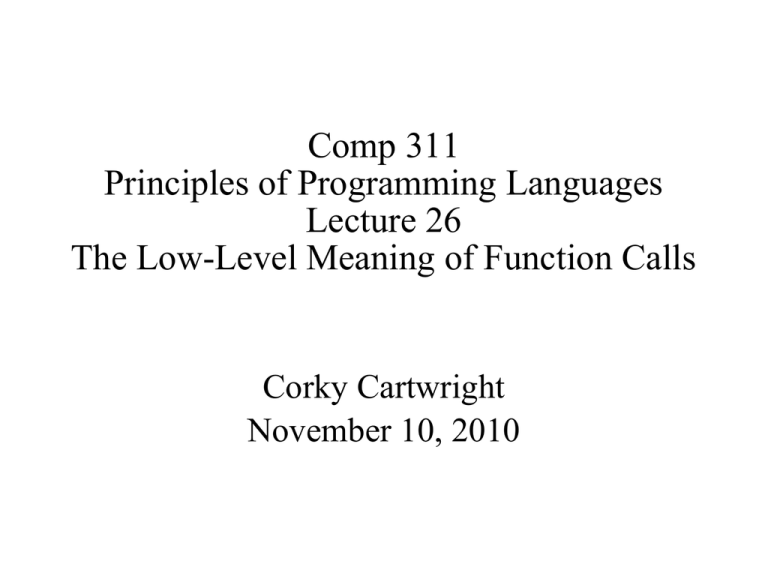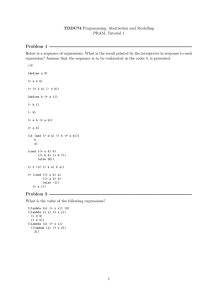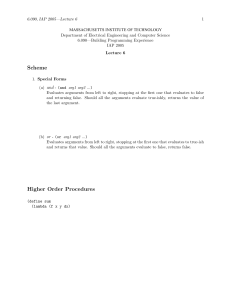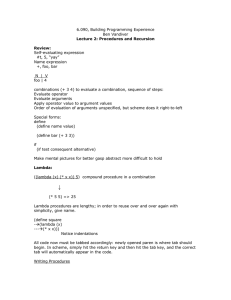Comp 311 Principles of Programming Languages Lecture 26
advertisement

Comp 311 Principles of Programming Languages Lecture 26 The Low-Level Meaning of Function Calls Corky Cartwright November 10, 2010 Machine-level Semantics Interpreters written in a clean functional metalanguage (like functional Scheme or Haskell) provide clear definitions of meaning for programming languages. We can even tolerate occasional use of imperative features (e.g., mutation operations on shared data in Scheme) and still claim that interpreters clearly define the behavior of programs (provided we define the semantics of our imperative extension of metalanguage). But these interpreters do not describe how to implement programming languages in terms of conventional machine instructions. What is missing? A description of the meaning of function calls and error operations used in the interpreter metalanguage. In principle we would like to know how to hand translate our interpreters to machine code, or even better, how to compile source programs directly into machine code. Guidance From an Example Consider the following procedure, which computes the product of a list of numbers: (define Pi (lambda (l) (cond ((null? l) 1) (else (* (first l) (Pi (rest l))))))) What if the input list may be corrupt (contain non-numbers)? (define Pi-acc (lambda (l acc) (cond ((null? l) acc) ((number? (first l)) (Pi-acc (rest l) (* (first l) acc))) (else (first l))))) ;; return erroneous input (define Pi-2 (lambda (l) (Pi-acc l 1)))) Does Pi-2 preserve the order of evaluation in Pi? Guidance From an Example cont. Suppose Pi-2 is passed a corrupt list. In that case, Pi-acc multiplies all the numbers found until the erroneous input is encountered. Can we avoid these wasted multiplications? Yes. By making acc into a suspension. (define Pi-acc (lambda (l acc) (cond ((null? l) (acc)) ((number? (first l)) (Pi/acc (rest l) (lambda () (* (first l) (acc))))) (else (first l))))) (define Pi-3 (lambda (l) (Pi/acc l (lambda () 1))))) This program avoids unnecessary multiplications. But like Pi-2, it changes the order of multiplications from Pi. If the * primitive were not associative, the transformation used to create Pi-2 would not work. Systematically Avoiding Nested Function Calls We failed to preserve the evaluation order in Pi in constructing Pi-2 and Pi-3 because updating an accumulator reverses the order of operations on a list. Is there a systematic way to avoid nesting function calls while preserving evaluation order? Yes! It is called transformation to continuation-passing style (CPS). The CPS transform of Pi is: (define Pi-k (lambda (l k) ;; k is the rest of the computation (cond ((null? l) (k 1)) ((number? (first l)) (Pi-k (rest l) (lambda (prod) (k (* (first l) prod))))) (else (first l))))) ;; escape on an illegal input! (define Pi-4 (lambda (l) (Pi-k l (lambda (x) x)))) Why does the (else ... ) clause work? It is because Pi-4 is tail-recursive; it is only called at top-level. Hence, the value returned by the else clause is guaranteed to return directly to the caller of Pi-4. CPS converts all functions to tail-form (no nested function calls). The CPS Transformation Assume Jam/Scheme programs are restricted to a form where the body of a function is either (i) a primitive expression constructed from constants, variables and primitive functions, and program-defined functions; or (ii) a conditional where the predicates are primitive expressions and the result clauses are ordinary expressions (primitive expressions augmented by program-defined functions) . Then the CPS transformation of such a program is defined as follows: 1. Add an extra parameter k to every function. 2. For each function body b that is a primitive expression, write (k b). a)3. Each clause in a conditional is treated separately: a) For each result clause b composed from primitive operations and constants, write (k b). b) For each clause containing calls on program-defined functions, pick the call that will be evaluated first. Make the body for the new clause a call that takes an extra argument, which is of the form (lambda (res) body). The original contents of that clause are placed in the body, enclosed in a call on the continuation k, with the selected recursive call replaced by res. – Repeat step (3b) until no unconverted function calls remain. Another Example (define Pi (lambda (t) (cond ((leaf? t) t) (else (* (Pi (left t)) (Pi (right t))))))) Then first iteration in creating the CPS version, Pi-k, is (define Pi-k (lambda (t k) ;; rule 1 (cond ((leaf? t) (k t)) ;; rule 3a (else ;; rule 3b (Pi-k (left t) (lambda (res) (k (* res (Pi (right t)))))))))) Second Iteration (define Pi-k (lambda (t k) ; rule 1 (cond ((leaf? t) (k t)) ; rule 3a (else ; rule 3b (Pi-k (left t) (lambda (r1) (Pi-k (right t) (lambda (r2) (k (* r1 r2))))))))))



